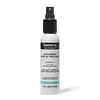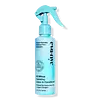What's inside
What's inside
 Key Ingredients
Key Ingredients

 Benefits
Benefits

 Concerns
Concerns

 Ingredients Side-by-side
Ingredients Side-by-side

Water
Skin ConditioningPropylene Glycol
HumectantCetearyl Alcohol
EmollientBehentrimonium Chloride
PreservativeNeopentyl Glycol Diheptanoate
EmollientParfum
MaskingQuaternium-80
Glycerin
HumectantIsododecane
EmollientDMDM Hydantoin
PreservativeMethylparaben
PreservativePanthenol
Skin ConditioningEthylparaben
PreservativeHydrolyzed Silk
HumectantButylene Glycol
HumectantHelianthus Annuus Seed
Skin ConditioningIodopropynyl Butylcarbamate
PreservativeAlthaea Officinalis Root Extract
Skin ConditioningAnthemis Nobilis Flower Extract
MaskingCamellia Oleifera Leaf Extract
AstringentCamellia Sinensis Leaf Extract
AntimicrobialEuterpe Oleracea Fruit Extract
Hydrolyzed Rice Protein
Skin ConditioningAlpha-Isomethyl Ionone
PerfumingBenzyl Alcohol
PerfumingBenzyl Benzoate
AntimicrobialCitronellol
PerfumingGeraniol
PerfumingHexyl Cinnamal
PerfumingHydroxycitronellol
PerfumingHydroxyisohexyl 3-Cyclohexene Carboxaldehyde
MaskingLinalool
PerfumingWater, Propylene Glycol, Cetearyl Alcohol, Behentrimonium Chloride, Neopentyl Glycol Diheptanoate, Parfum, Quaternium-80, Glycerin, Isododecane, DMDM Hydantoin, Methylparaben, Panthenol, Ethylparaben, Hydrolyzed Silk, Butylene Glycol, Helianthus Annuus Seed, Iodopropynyl Butylcarbamate, Althaea Officinalis Root Extract, Anthemis Nobilis Flower Extract, Camellia Oleifera Leaf Extract, Camellia Sinensis Leaf Extract, Euterpe Oleracea Fruit Extract, Hydrolyzed Rice Protein, Alpha-Isomethyl Ionone, Benzyl Alcohol, Benzyl Benzoate, Citronellol, Geraniol, Hexyl Cinnamal, Hydroxycitronellol, Hydroxyisohexyl 3-Cyclohexene Carboxaldehyde, Linalool
Water
Skin ConditioningGlycerin
HumectantCetearyl Alcohol
EmollientButylene Glycol
HumectantBehentrimonium Chloride
PreservativeSodium Hyaluronate
HumectantSh-Polypeptide-121
Skin ConditioningOryza Sativa Extract
AbsorbentAlthaea Officinalis Root Extract
Skin ConditioningOlea Europaea Fruit Oil
MaskingPrunus Amygdalus Dulcis Oil
Skin ConditioningSesamum Indicum Seed Oil
EmollientGuar Hydroxypropyltrimonium Chloride
Skin ConditioningQuaternium-80
Tetrasodium Glutamate Diacetate
Lauryl Laurate
Skin ConditioningPanthenol
Skin ConditioningGlycereth-17 Cocoate
EmulsifyingPotassium Sorbate
PreservativeSodium Benzoate
MaskingBenzoic Acid
Masking1,2-Hexanediol
Skin ConditioningEthylhexylglycerin
Skin ConditioningPhenoxyethanol
PreservativeParfum
MaskingWater, Glycerin, Cetearyl Alcohol, Butylene Glycol, Behentrimonium Chloride, Sodium Hyaluronate, Sh-Polypeptide-121, Oryza Sativa Extract, Althaea Officinalis Root Extract, Olea Europaea Fruit Oil, Prunus Amygdalus Dulcis Oil, Sesamum Indicum Seed Oil, Guar Hydroxypropyltrimonium Chloride, Quaternium-80, Tetrasodium Glutamate Diacetate, Lauryl Laurate, Panthenol, Glycereth-17 Cocoate, Potassium Sorbate, Sodium Benzoate, Benzoic Acid, 1,2-Hexanediol, Ethylhexylglycerin, Phenoxyethanol, Parfum
Ingredients Explained
These ingredients are found in both products.
Ingredients higher up in an ingredient list are typically present in a larger amount.
Althaea Officinalis Root Extract is from a plant called the Marsh Mallow plant. This plant is indigenous to Europe, West Asia, and North Africa.
Marsh Mallow root is an emollient and antioxidant. It helps sooth and soften the skin. When applied to the skin, it blocks enzymes that break down hyaluronic acid.
The marshmallow we eat today is based on an ancient Egyptian dessert made from this plant (Marshmallows do not contain this plant anymore).
Learn more about Althaea Officinalis Root ExtractThis ingredient is a preservative and often used for it's anti-static properties. You'll most likely see this ingredient in hair conditioners.
It does not cause irritation or sensitization in leave-on products at 1-5%.
Butylene Glycol (or BG) is used within cosmetic products for a few different reasons:
Overall, Butylene Glycol is a safe and well-rounded ingredient that works well with other ingredients.
Though this ingredient works well with most skin types, some people with sensitive skin may experience a reaction such as allergic rashes, closed comedones, or itchiness.
Learn more about Butylene GlycolCetearyl alcohol is a mixture of two fatty alcohols: cetyl alcohol and stearyl alcohol. It is mainly used as an emulsifier. Emulsifiers help prevent the separation of oils and products. Due to its composition, it can also be used to thicken a product or help create foam.
Cetearyl alcohol is an emollient. Emollients help soothe and hydrate the skin by trapping moisture.
Studies show Cetearyl alcohol is non-toxic and non-irritating. The FDA allows products labeled "alcohol-free" to have fatty alcohols.
This ingredient is usually derived from plant oils such as palm, vegetable, or coconut oils. There is debate on whether this ingredient will cause acne.
Due to the fatty acid base, this ingredient may not be Malassezia folliculitis safe.
Learn more about Cetearyl AlcoholGlycerin is already naturally found in your skin. It helps moisturize and protect your skin.
A study from 2016 found glycerin to be more effective as a humectant than AHAs and hyaluronic acid.
As a humectant, it helps the skin stay hydrated by pulling moisture to your skin. The low molecular weight of glycerin allows it to pull moisture into the deeper layers of your skin.
Hydrated skin improves your skin barrier; Your skin barrier helps protect against irritants and bacteria.
Glycerin has also been found to have antimicrobial and antiviral properties. Due to these properties, glycerin is often used in wound and burn treatments.
In cosmetics, glycerin is usually derived from plants such as soybean or palm. However, it can also be sourced from animals, such as tallow or animal fat.
This ingredient is organic, colorless, odorless, and non-toxic.
Glycerin is the name for this ingredient in American English. British English uses Glycerol/Glycerine.
Learn more about GlycerinPanthenol is a common ingredient that helps hydrate and soothe the skin. It is found naturally in our skin and hair.
There are two forms of panthenol: D and L.
D-panthenol is also known as dexpanthenol. Most cosmetics use dexpanthenol or a mixture of D and L-panthenol.
Panthenol is famous due to its ability to go deeper into the skin's layers. Using this ingredient has numerous pros (and no cons):
Like hyaluronic acid, panthenol is a humectant. Humectants are able to bind and hold large amounts of water to keep skin hydrated.
This ingredient works well for wound healing. It works by increasing tissue in the wound and helps close open wounds.
Once oxidized, panthenol converts to pantothenic acid. Panthothenic acid is found in all living cells.
This ingredient is also referred to as pro-vitamin B5.
Learn more about PanthenolParfum is a catch-all term for an ingredient or more that is used to give a scent to products.
Also called "fragrance", this ingredient can be a blend of hundreds of chemicals or plant oils. This means every product with "fragrance" or "parfum" in the ingredients list is a different mixture.
For instance, Habanolide is a proprietary trade name for a specific aroma chemical. When used as a fragrance ingredient in cosmetics, most aroma chemicals fall under the broad labeling category of “FRAGRANCE” or “PARFUM” according to EU and US regulations.
The term 'parfum' or 'fragrance' is not regulated in many countries. In many cases, it is up to the brand to define this term.
For instance, many brands choose to label themselves as "fragrance-free" because they are not using synthetic fragrances. However, their products may still contain ingredients such as essential oils that are considered a fragrance by INCI standards.
One example is Calendula flower extract. Calendula is an essential oil that still imparts a scent or 'fragrance'.
Depending on the blend, the ingredients in the mixture can cause allergies and sensitivities on the skin. Some ingredients that are known EU allergens include linalool and citronellol.
Parfum can also be used to mask or cover an unpleasant scent.
The bottom line is: not all fragrances/parfum/ingredients are created equally. If you are worried about fragrances, we recommend taking a closer look at an ingredient. And of course, we always recommend speaking with a professional.
Learn more about ParfumWe don't have a description for Quaternium-80 yet.
Water. It's the most common cosmetic ingredient of all. You'll usually see it at the top of ingredient lists, meaning that it makes up the largest part of the product.
So why is it so popular? Water most often acts as a solvent - this means that it helps dissolve other ingredients into the formulation.
You'll also recognize water as that liquid we all need to stay alive. If you see this, drink a glass of water. Stay hydrated!
Learn more about Water